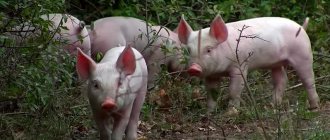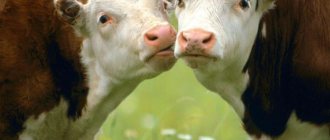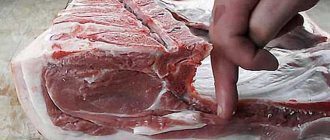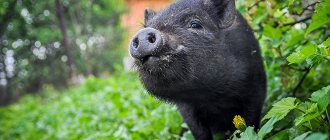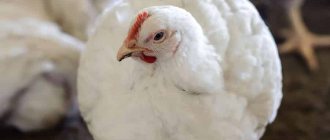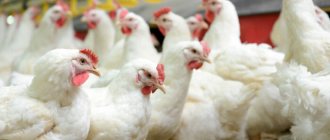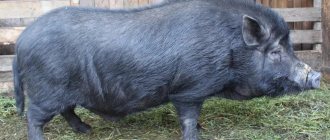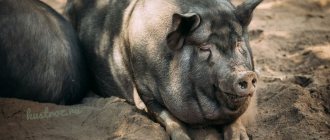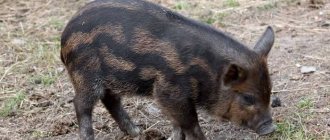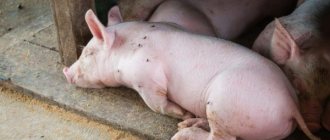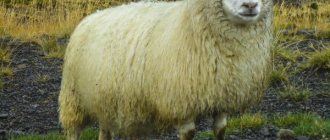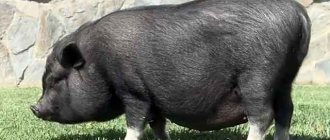Average weight of an animal at slaughter
The weight of a grown animal is directly dependent on the selected variety and proper diet. One of the heaviest animals is the large white breed. For example, the weight of sows reaches 320-340 kg. They are not inferior to wild boars, giving figures of 320-350 kg. The normal average weight of a pig is 210-260 kg.
Increasing the weight of a piglet most of all depends on the organization of competent feeding. On average, at 3-4 months, representatives of any breed reach 55-65 kg, and if fed ad libitum, the animal will reach 100 kg at 3 months.
The weight of Vietnamese pot-bellied pigs can be 150 kg. But usually they are slaughtered early at 6-7 months, weighing 70-80 kg.
It is not difficult to determine how much a pig weighs on average. You can use scales or other methods that we talked about in the article “Measuring the weight of a pig using a table.”
Information on weight before fattening period
The most life-threatening, and therefore the most labor-intensive times for pig farmers, are 4 months from the birth of piglets. During this period, the animals’ immunity has not yet strengthened, their body may not develop correctly, and pathologies may appear. The easiest way to track changes is in the piglet weight table, which shows normal indicators for the “critical” age.
It is very convenient to work with such a summary, because it reflects data not only by month, but also by week and day. So, you can easily find out that at 1 month the average weight of a pig is 8.9 kg, and that of a three-month-old pig is 38 kg and 400 g. In addition, you can see how the baby gains weight at 2 months, and that weekly he gains about 3 kg.
But, remember that the given data are average statistical indicators, which do not take into account special diets and living conditions of animals. This clause is important, since with intensive feeding and the use of supplements, babies will grow faster than pigs whose diet is not balanced.
The same applies to care, because poor living conditions have a detrimental effect on health, as a result of which pigs lose, rather than gain, kilograms.
Pork meat yield from live weight
Above we talked about live weight; slaughter weight is a different concept. This refers to the yield of a pure product after cutting the animal. These indicators do not include internal organs, skin and legs (lower part). Accordingly, the figure is always smaller. Let's take a closer look at this and other concepts.
Pigs are one of the most profitable animals in terms of obtaining a meat product. When cutting a pig, the least amount of waste is produced. So, slaughter weight means a carcass with the skin removed, the head, lower parts of the limbs, and internal organs removed.
Boning involves separating bones from muscle tissue. The slaughter yield is considered to be the percentage of the mass obtained after slaughter of the carcass to the live one.
After slaughtering an animal weighing 100 kg, clean meat comes out from 63 to 72 kg. At the same time, lard accounts for 14-24 kg. The deboning yield rates show that the amount of product in percentage terms is 63-72%. All these are average statistical indicators.
If the pig moves a lot, then the sebaceous layer will be small, and if the animal has a passive lifestyle, there will be less pure pork - all the nutrition is used to accumulate fat.
How much meat and other products, as a percentage, will be obtained when slaughtering an individual weighing 100 kg is shown in the table of meat (pork) yield based on live weight:
Keep in mind that the table shows average data. Figures may vary depending on the breed of pigs, their age, and individual characteristics.
Weight of carcass, half carcass and various parts of the animal
The live weight of an animal is the weight before slaughter. After slaughter, cutting and processing, it is divided into parts. Most often, a pig carcass weighing 110 kg has 74 kg of meat product, 22 kg of lard, as well as 11 kg of bones and about 3 kg of various waste.
The weight of a half carcass after removing the bones and fat is on average 35-40 kg. In a meat breed pig, the amount of bacon will be 13%, and in an individual with a high fat content factor - 25%. About 12% of the total weight of the side carcass is on the bone. Losses during cutting are approximately 1%.
Regardless of the breed of young animals, the yield of pork in comparison with the amount of fat obtained is greater than that of adult animals that are fattened.
The head of an animal weighing 120 kg weighs about 10 kg, and the hind leg weighs about 8-9 kg. The average weight of a month-old pig is 7-9 kg. At 5 months it reaches 85-90 kg. The yield of pure meat from this individual is within 40 kg without bones and offal.
Description and size of wild boar
The wild boar belongs to the order of artiodactyl animals and forms a separate genus in the family. It is also often called the boar. This animal is the direct ancestor of the current domestic pig. As for appearance, it is not difficult to distinguish it from a modern domestic boar.
The wild boar has a denser build and longer legs. The head shape of a wild boar is elongated. The ears on the head are long and erect. Males differ from females in having more developed upper and lower canines. The boar's body is covered with coarse long hair. There is a mane on the head and back. In winter, the fur becomes denser, and in summer it thins out. Hair color can be grey, dark or brown.
As for the size of the wild boar, it may vary depending on the habitat of the animal. The further north a wild boar lives, the larger it will be. The smallest individuals can be found in southeast Asia and southern India. The weight of such boars reaches only 45 kg. But in the Carpathians, wild boars can weigh about 200 kg. The largest individuals live in the regions of the Urals in Russia. Their weight reaches as much as 300 kg. The maximum weight that was recorded was 320 kg. Large wild boars weighing 150 kg can also be found in Italy. In France, the weight of boars can reach 230 kg.
The average weight of wild boars is 100 kg. The body length of the animal reaches 2 m, and the height at the withers is 110 cm. The length of the boar's tail does not exceed 40 cm. And the length of the fangs can vary from 6 to 12 cm.
Pork categories
Pork after slaughter is used as a table product and for the production of sausages, canned food and various smoked products. The selection of products is carried out according to the category of meat, which, depending on the heat treatment used, can be cooled, chilled or frozen.
Unlike beef, pork is dense, soft and tender meat, which at different ages of individuals has a different color - from light pink (in young ones) to red (in more mature ones).
The classification of pork depends on the degree of fatness of the animal. The resulting product is divided into:
The first category refers to dairy piglets one month old with a carcass weight of 5 to 9 kilograms. Others talk about the purpose of raising animals.
Pig meat output
The size of the slaughter yield is influenced by many reasons. Some of the most important factors are the animal’s physique and the meat properties of the breed being raised. Compact pigs often have a higher percentage of meat yield compared to long, tall pigs.
Increased fatness of the animal intended for slaughter has a positive effect on the amount of product. Its value increases with the same weight of offal and bones.
As the animal gains weight, the slaughter yield also increases, because the amount of offal does not increase much after a certain age. The influence of the animal's sex is also important: for example, a castrated boar has 1.5% less meat than a pig with the same pre-slaughter weight.
The slaughter weight will be higher for individuals that were fed with special feed or other components with useful elements.
If the material was useful to you, please like it.
Share your own thoughts in the comments below.
A farmer involved in livestock farming needs to be able to determine the yield of pork meat from live weight in different ways. Its percentage depends on the breed, age, and feeding. The slaughter weight of a pig helps to pre-calculate the farm’s profit, determine the profitability of production, and adjust feeding standards.
conclusions
- You can measure/measure/measure the body weight of a living pig not only using scales, but also using tables, diagrams and formulas (measure an individual and its dimensions using a tape measure, a meter, as in the old days).
- You can calculate the weight of pig meat products immediately before slaughter and hand them over to a meat processing plant or for purchase.
- The yield of lard, meat and bacon will depend on the breed and its type, as well as on the age and gender of the pig (a significant factor if the pig is in heat or has given birth).
- It is important to track the weight of young animals in order to compare it with the standard and pay attention to possible even minimal deficiencies in fattening.
Read about how to cut up a pig carcass at this link.
Average pig weight at slaughter
The age, breed, and diet of the animal directly affect weight. To determine the time of slaughter, the expected slaughter weight of the pig, the health of the animal and the preparation of a feeding ration, it is necessary to be able to correctly determine the weight of the animal.
Representatives of the Great White breed reach impressive sizes in adulthood: wild boar - 350 kg, pig - 250 kg. The Mirgorod breed is smaller, individuals rarely reach 250 kg.
A Vietnamese boar weighs 150 kg, a pig – 110 kg.
The increase in piglet weight gain depends on the correct composition of the diet, the quality of the feed, and the time of year. The weight of the animal increases in the spring when healthy greens are added to high-calorie feed. The indicator is influenced by the pig’s fatness, which is represented by five categories:
- the first is young bacon type, up to 8 months, weighing 100 kg;
- the second – young meat animals, up to 150 kg, gilts – 60 kg;
- the third - fatty individuals without age restrictions with a fat thickness of 4.5 cm;
- fourth - sows and hogs and heavier than 150 kg, the thickness of their fat is 1.5 - 4 cm;
- fifth – suckling piglets (4 – 8 kg).
Weight gain largely depends on the diet, the addition of vitamins to the pigs’ feed, and the conditions of detention. With a balanced and high-calorie diet, by six months the animal can gain 120 kg. This weight gives a high slaughter yield for pigs.
How much does a boar weigh?
Adult boars weigh more than pigs. The difference is 100 kg. Average values of different breeds of adult boars (in kg):
- Mirgorodskaya - 250, at breeding enterprises - 330;
- Lithuanian white – 300;
- Livenskaya – 300;
- Latvian white – 312;
- Kemerovo - 350;
- Kalikinskaya – 280;
- Landrace - 310;
- Large black – 300 – 350;
- Large white – 280 – 370;
- Duroc – 330 – 370;
- Chervonopoyasnaya – 300 – 340;
- Estonian bacon – 320 – 330;
- Welsh – 290 – 320;
- Siberian Northern – 315 – 360;
- Ukrainian steppe white – 300 – 350;
- North Caucasian – 300 – 350.
Weight of piglets before slaughter
The specific weight of a pig at different ages allows for correction of the quality and quantity of feedings. For all breeds there are average animal weights. Thus, a Large White piglet is much heavier than an Asian herbivore. The weight of piglets, depending on age, has approximate values.
The indicator is influenced by the amount of farrowing of the sow. The more numerous it is, the lighter the piglets. The first month of weight gain depends on the milk production of the pig. From the second month, the quality of nutrition affects the growth of piglets.
Concentrated food promotes rapid weight gain. A diet based on grass, vegetables and fruits slows the rate at which pigs gain weight. When comparing the weight of a piglet with standard values, it is necessary to take into account information about feeding. Increase in piglet weight gain by month (on average, in kg):
The error in the mass of Landraces, Large Whites and other breeds that are not fattened before slaughter for more than six months is 10%.
Calculation by formula
The real live weight of young animals depends not only on the size of the body, but also on the external fatness of the animals, which is determined “by eye”.
To more accurately determine the weight of piglets, data from similar measurements are taken and calculated using the formula:
back length (cm) × chest circumference (cm) ÷ fatness coefficient.
Fatness groups
In accordance with the interstate standard in force in Russia (GOST 31476-2012), experts divide pigs intended for slaughter according to sex, age and degree of fatness into six categories or groups.
The first group includes young white bacon breeds without pigment spots (for example, Landrace) under the age of 8 months, fed using special technology. The length of the animal's body (without interception behind the shoulder blades) should be at least 1 meter, the average weight of the pig should be in the range of 70-100 kg, and the thickness of the subcutaneous fat layer in the area of the 6-7th thoracic vertebrae (above the spinous processes) should not be more than 2 cm .
The second group of fatness includes young meat breeds with a live weight of 70 to 150 kg with a backfat thickness of no more than 3 cm, and gilts from 20 to 70 kg (fat with a layer of at least 1 cm).
Barberry: description, types and varieties, planting in open ground, care, features for different climatic conditions including Siberia (65 Photos & Videos) + Reviews
The third group also includes pigs and boletus - young animals weighing up to 150 kg, but with a layer of fat over 3 cm.
The fourth group includes fatty pigs of universal (for example, Large White) and lard breeds - sows without restrictions on live weight, and hogs over 150 kg, with a subcutaneous fat thickness of at least 1 cm.
The fifth group consists of suckling pigs (4-10 kg each), in which the ribs and processes of the dorsal vertebrae do not protrude, and the skin is white or slightly pink, without damage.
The sixth group includes boars with a live weight of no more than 60 kg and a layer of fat from 1 cm.
What determines the lethal yield?
After the slaughter of an animal, part of the weight is lost due to evisceration of the carcass, bleeding, separation of legs, skin, and head. The percentage of pork meat yield based on live weight is called slaughter yield. The indicator is influenced by the type of animal, characteristics of the breed, age, fatness, and gender. It is widely used to assess the quality of livestock. The yield of pork from a carcass depends quite critically on the accuracy of measuring live weight. If it is determined incorrectly, the error reaches large values.
Thus, the weight of a pig carcass fluctuates depending on the time of weighing. In the steamed state, it is 2–3% heavier than in the cooled state. The body tissues of a young animal contain more moisture than an adult, therefore, the loss of kilograms after slaughter in the first case is more significant.
The change in weight is higher for fatty carcasses than for lean carcasses.
Product yield is affected by:
- diet – fiber results in less weight gain than food with a dense consistency;
- transportation – during delivery to the slaughterhouse, animals become 2% lighter due to stress;
- lack of feeding - before slaughter, 3% of weight is lost in 24 hours without food, as the body spends energy on mobilizing vital functions.
Slaughter yield of pig meat
The slaughter yield for pigs is 70–80%. It is equal to the ratio of carcass weight to live weight, expressed as a percentage. The slaughter weight of pigs includes the carcass with the head, skin, fat, without legs, bristles and internal organs, excluding kidneys and kidney fat.
- With a live weight of a pig of 80 kg, carcass without legs and offal (excluding kidneys) - 56 kg, the slaughter yield is equal to: 56 / 80 = 0.7, which is equal in percentage - 70%;
- With live weight - 100 kg, slaughter weight - 75 kg, the yield is: 75 / 100 = 0.75 = 75%;
- With a live weight of 120 kg and carcass weight of 96 kg, the yield is: 96 / 120 = 0.8 = 80%.
Judging by the indicator, raising pigs is more profitable than raising cattle and sheep. Product yield, compared to other animals, is 25% more. This is possible due to the low bone content. Cattle have 2.5 times more of them than pigs.
The slaughter yield for farmed animals is:
- cattle – 50 – 65%;
- sheep – 45 – 55%;
- rabbits – 60 – 62%;
- poultry – 75 – 85%.
How much does a pork carcass weigh?
In a pig, the yield of meat, lard, and offal depends on the breed, age, and weight of the animal itself.
All bred breeds are divided into three groups:
- Bacon: Pietrain, Duroc, quickly gaining kilograms with a slow build-up of fat and a fast build-up of muscles; have a long body, massive hams;
- Greasy: Hungarian, Mangalitsa, have a wide body, heavy front, meat - 53%, lard - 40%;
- Meat production: Livenskaya, Large White – universal breeds.
When the live weight of a pig reaches one hundred kilograms or more, the slaughter yield is 70–80%. In addition to meat, the composition includes about 10 kg of bones, 3 kg of waste, 25 kg of lard.
Internal weight
The weight of liver products depends on the age of the pig, its breed, and size. For a 100 kg carcass it is (in kg):
The percentage of viscera in relation to the total slaughter yield is:
What percentage of meat is in a pig
After slaughter, pig carcasses are divided into half carcasses or quarters. Next, they are divided into cuts, deboning, trimming, and trimming.
Boning is the processing of sides and quarters, in which muscle, fat, and connective tissues are separated from the bones. After it, there is practically no meat on the bones.
The vein is the separation of tendons, films, cartilage, and remaining bones.
On different parts of half carcasses, the yield of pork meat after deboning is of different quality. This is the peculiarity of the procedure. So, when deboning the brisket, back, and shoulders, meat of lower grades is cut off than from other parts. This is due to the large number of veins and cartilage. The trimmer provides, in addition to further cleaning, the final sorting of pork. It is divided into muscle groups, cut longitudinally into kilogram pieces, and the connective tissue is separated from them.
When a carcass is taken to be one hundred percent after slaughter, the yield standards for deboning pork are:
- meat – 71.1 – 62.8%;
- lard – 13.5 – 24.4%;
- bones – 13.9 – 11.6%;
- tendons and cartilage – 0.6 – 0.3%;
- losses – 0.9%.
How much pure meat is in a pig?
Pork is divided into five categories:
- the first is bacon, the animals are specially fattened, there are layers of fat and highly developed muscle tissue;
- the second is meat, it includes carcasses of young animals (40 - 85 kg), the thickness of the bacon is 4 cm;
- third - fatty pork, bacon more than 4 cm;
- fourth – raw materials for industrial processing, carcasses heavier than 90 kg;
- fifth - piglets.
Fourth, fifth categories: pork frozen several times, products obtained from boars are not allowed for sale. The yield of pork cuts to carcass weight is 96%.
The yield of meat, lard and other components from a pig with a live weight of 100 kg is (in kg):
- internal fat – 4.7;
- head – 3.6;
- legs – 1.1;
- meat – 60;
- ears – 0.35;
- trachea – 0.3;
- stomach – 0.4;
- liver – 1.2;
- language – 0.17;
- brains – 0.05;
- heart – 0.24;
- kidneys – 0.2;
- lung – 0.27;
- trim – 1.4.
How much meat is in a 100 kg pig?
When slaughtering pigs that have gained 100 kg, the yield is 75%. Carcasses with a high percentage of bacon are obtained as a result of fattening hybrids of three breeds: Landrace, Duroc, Large White. Bacon meat is rich in muscle tissue and thin bacon. It ripens on the 5th – 7th day after slaughter, when its nutritional value becomes maximum and its properties are optimal for further processing. After 10–14 days it is most tender and juicy. The average weight of half carcasses is 39 kg, the backfat has a thickness of 1.5 - 3 cm. The percentage of clean meat yield from a pig carcass is:
- carbonate – 6.9%;
- shoulder blade – 5.7%;
- brisket – 12.4%;
- hip part – 19.4%;
- cervical part – 5.3%.
Average pig weight
The weight of a grown pig depends on the chosen breed and proper feeding. The heaviest are large white pigs, the most common in Russia. The weight of a white boar reaches 300-350 kg, and the weight of a boar of the Mirgorod breed is about 230-260 kg. For a pig, the normal average is 200-250 kg. However, a small Vietnamese pig can reach 140 kg, and a large white breed sow weighs twice as much - up to 330-350 kg.
p, blockquote 2,0,0,0,0 –>
Increasing the weight of piglets depends on proper quality feeding. This is 50-60 kg at the age of 3-4 months, and when fed ad libitum, the piglet reaches 90 kg or more in 3 months.
p, blockquote 3,0,0,0,0 –>
Determination of live weight without scales
Not every household has suitable instruments, but the weight of a pig can be determined quite accurately without them. There are several ways. To be on the safe side, you can use them all at once.
p, blockquote 4,0,0,0,0 –>
To calculate, you will need to measure the chest circumference and body length of the animal. Chest girth is determined by placing a measuring tape behind the front legs at the corners of the shoulder blades. Body length is measured from the middle of the back of the head to the root of the tail. To avoid errors in calculations, the pig should not raise or lower its head when measuring.
p, blockquote 5,0,1,0,0 –>
Simplified formula
Using a simple formula, you can calculate live weight, and then the meat yield - from 100 kg you get approximately 70 kg of clean meat.
Live weight = 1.54 * A + 0.99 * B – 150, where:
p, blockquote 7,0,0,0,0 –>
A – chest circumference; B – body length.
p, blockquote 8,0,0,0,0 –>
Formula based on fat content
The body condition index for fatty pigs is 142, for medium-fat meat-fat breeds it is 156, and for lean animals it is 162.
p, blockquote 9,0,0,0,0 –>
Multiply chest circumference with torso length, and divide the result by the specified constant.
p, blockquote 10,1,0,0,0 –>
Definition from the table
The mass is determined at the intersection of the same measurements.
p, blockquote 11,0,0,0,0 –>
The biomass of a fattened piglet may change during the day. Net weight is the body weight of an animal without the contents of the stomach, intestines, and bladder. Therefore, the animal is weighed several hours before feeding.
p, blockquote 12,0,0,0,0 –>
Methods of measuring according to the scheme: which is easiest at home
In addition to conventional weighing, one of three measurement technologies can be used. In order for the calculations to be as accurate as possible, it is important to strictly follow the instructions and recommendations.
By measurements: using a tape measure, measuring the individual by size, height
Some experienced breeders are able to determine the weight of an animal “by eye”. However, if experience is not enough, you can use measurement tables.
First of all, you should prepare two measurements: the length of the body from the back of the head to the tail, as well as the circumference of the chest just under the shoulder blades. While determining the parameters, the animal’s head should look forward; to do this, it will need to be distracted by something. To make measurements more accurate, you must use the following recommendations:
- measurements should be taken only early in the morning;
- you can feed the animal only after measurements;
- Only a soft tape should be used for the procedure, without tightening the carcass with it.
Next, the results obtained must be compared with the tabulated ones. It shows both parameters, at the intersection of which you can find the approximate weight of the carcass. The error in the indicators ranges from four to eleven percent. Read about fattening pigs.
Using the formula to measure weight
The measurement formula is used to populate the table above. Therefore, you can also use it yourself, and with better accuracy.
In identical equality, let us take the chest girth as the indicator X, and the length of the torso as the indicator Y. Both numbers must be entered into the formula in centimeters. Next you will need to perform the following calculations:
Approximate weight of a pig = 1.54 * X + 0.99 * Y – 150.
The error in this case may be less than five percent. It is recommended to round the result downwards.
By fatness category
Using the formula for the fatness category, you can obtain data that is close to the most accurate. To do this, you will also need an additional parameter N, called the fatness coefficient. For fat pigs it is 142, medium - 156 and thin - 162.
The fatness category can be determined by the following parameters:
- carcass shape;
- thickness of fat (can be determined by touch by the vertebrae);
- age;
- floor.
Greasy breeds are classified as fatty. They have rounded shapes, often their neck almost merges with the shoulder blades. The vertebrae cannot be palpated; the thickness of the sebaceous layer is five to seven centimeters. The medium category usually includes bacon breeds, the thickness of which is from three to five centimeters. The vertebrae of animals are weakly palpable.
The thin category, as a rule, consists of meat breeds whose backfat thickness does not exceed three centimeters. In such animals, the vertebrae are easily palpable; the shoulder blades are not connected to the neck.
Determination of live weight of a pig by fatness
Having determined the category by indicators, you can use the formula:
Approximate live weight = (X * Y) / N.
These methods can be used to measure both adult animals and young animals.
Killer exit
This is the percentage ratio of the carcass weight after processing to the live weight of the pig before slaughter. During slaughter, the animal is bled, gutted, the hock and carpal joints of the leg and head are cut off, and the skin is removed. The remaining amount of meat, bones, and fat is called slaughter yield. This indicator depends on the breed, age, sex, type of fattening, and degree of fatness.
p, blockquote 13,0,0,0,0 –>
The slaughter yield of meat and lard averages 70-85%. With a live weight of a pig of 100 kg, the production will be 72-75%, 120-150 kg - 77-80%, over 180 kg - 80-85%. The average is 77%, without by-products - 66%.
p, blockquote 14,0,0,0,0 –>
You can determine how much meat you can get from a pig with an initial weight of 110 kg by subtracting about 2.5-3 kg of waste and about 10 kg of bones. The lard will account for approximately 23 kg. As a result, we get 73 kg in net calculation.
p, blockquote 15,0,0,1,0 –>
The head of a 100-kilogram carcass weighs about 8-9 kg, the liver - 1.6 kg, the heart - 320 g, the kidneys - 260 g, the lungs - 800 g.
There is also a formula to determine slaughter weight:
Carcass weight after slaughter before cooling / pre-slaughter live weight of the pig x 100
How to find out how much a piglet weighs
The weight of piglets at birth, as well as in the first weeks of life, is determined on portable scales. Further determination is carried out in an evaluative way according to growth change tables. However, upon reaching a weight of 25-30 kg, it is necessary to separate individuals for herd repair and fattening. The feeding schedule for gilts will be different. This is where measurements come in handy.
Piglet weight table by week
The approximate weight of piglets by week of rearing is shown in the table:
| Age, weeks | Live weight, kg |
| 1 | 2,5 |
| 2 | 4,5 |
| 3 | 7 |
| 4 | 9 |
| 5 | 11 |
| 6 | 14 |
| 7 | 18 |
| 8 | 22 |
| 9 | 26 |
| 10 | 30 |
Therefore, measurements should be carried out at the 9-10th week of the piglet’s life.
Weight of piglets by month: table
After placement for fattening or raising replacement young stock, selective monitoring of the live weight of gilts is recommended to be carried out monthly.
Visually select at least 5 medium-sized individuals from each cell, take measurements and compare with the approximate growth plan presented in the table:
| Age, months | Live weight, kg |
| 3 | 39 |
| 4 | 45 |
| 5 | 65 |
| 6 | 85 |
| 7 | 110 |
Selling for meat is carried out upon reaching a live weight of 90-110 kg. Further fattening is impractical, since growth occurs due to lard, the market value of which is lower than meat.
Factors influencing meat yield
Before slaughter, pigs are given food no later than 8-12 hours in advance, and they try to expose them to the least amount of stress. List of factors according to which indicators can be determined:
p, blockquote 18,0,0,0,0 –>
- Accurate weighing before and after slaughter provides the most accurate data for obtaining pork from a single animal.
- Keeping piglets on slatted floors increases weight compared to rearing them on straw bedding.
- Carcasses are heavier in meat breeds. A Landrace or Pietrain pig produces more pork than a large white pig.
- A castrated boar is 1% less in slaughter weight than an uncastrated boar, and 1.5% lower than a pig due to the difference in the weight of the genitals.
- Diet composition, feed quality and feeding level also affect production yield. Eating diets high in fiber results in less weight gain than diets rich in nutrient dense foods.
- Prolonged deprivation of nutrition mobilizes the body to perform vital functions. During a day without feeding, an animal can lose up to 3.5-3.8% of body weight and up to 2% of carcass weight, respectively.
- When slaughtered at a slaughterhouse, transporting animals reduces slaughter weight by up to 2%. As a result of stress, pigs lose a kilogram of live weight every quarter of the day.
- The experience of the slaughterer and cutter of pigs also influences the yield of meat products.
In terms of output for consumption, pig farming is more profitable than raising cattle and sheep. Compared to other types of animals, the pork yield is 20-25% higher. There is 2.5 times less in pork carcasses and bones. The content of the highest percentage of edible solids in meat, the chemical composition and characteristic taste are valued by consumers and increase the profitability of raising pigs for fattening.
p, blockquote 19,0,0,0,0 –> p, blockquote 20,0,0,0,1 –>
